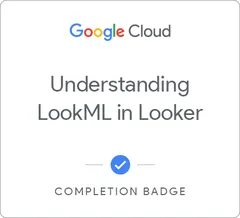
Understanding LookML in Looker 
Get a comprehensive overview of Understanding LookML in Looker ▼
ADVERTISEMENT
Course Feature
![]() Cost:
Cost:
Free
![]() Provider:
Provider:
Qwiklabs
![]() Certificate:
Certificate:
Free Certification
![]() Language:
Language:
English
![]() Start Date:
Start Date:
On-Demand
Course Overview
❗The content presented here is sourced directly from Qwiklabs platform. For comprehensive course details, including enrollment information, simply click on the 'Go to class' link on our website.
Updated in [May 19th, 2023]
This course provides an overview of LookML in Looker. Participants will gain hands-on experience with LookML, learning how to write code to create new dimensions and measures, create derived tables and join them to Explores, filter Explores, and define caching policies in LookML. By the end of the course, participants will have a better understanding of LookML and how to use it to create powerful data models.
[Applications]
After completing this course, learners can apply their knowledge of LookML in Looker to create custom Explores, build data models, and create custom visualizations. Learners can also use LookML to create custom dashboards and reports, as well as to optimize query performance. Additionally, learners can use LookML to create custom data pipelines and automate data processing tasks.
[Career Paths]
1. Business Intelligence Analyst: Business Intelligence Analysts are responsible for collecting, analyzing, and interpreting data to help inform business decisions. They use data analysis tools such as Looker to create reports and dashboards that provide insights into customer behavior, market trends, and other business metrics. As the demand for data-driven decision-making increases, the need for Business Intelligence Analysts is expected to grow.
2. Data Scientist: Data Scientists use advanced analytics techniques to uncover insights from large datasets. They use tools such as Looker to explore and analyze data, develop predictive models, and create visualizations to communicate their findings. As businesses become increasingly data-driven, the demand for Data Scientists is expected to continue to grow.
3. Data Engineer: Data Engineers are responsible for designing, building, and maintaining data pipelines. They use tools such as Looker to create data models, ETL processes, and data warehouses. As businesses become more reliant on data, the need for Data Engineers is expected to increase.
4. Data Visualization Specialist: Data Visualization Specialists are responsible for creating visualizations that help people understand data. They use tools such as Looker to create interactive dashboards and visualizations that make it easier to explore and analyze data. As businesses become more reliant on data, the demand for Data Visualization Specialists is expected to grow.
[Education Paths]
1. Data Science Degree: Data Science is a rapidly growing field that combines mathematics, statistics, computer science, and domain expertise to extract insights from data. With a Data Science degree, you will learn how to use data to solve complex problems, develop predictive models, and create data-driven solutions. As the demand for data-driven solutions continues to grow, so does the need for Data Science professionals.
2. Business Analytics Degree: Business Analytics is a field that focuses on using data to make better business decisions. With a Business Analytics degree, you will learn how to analyze data to identify trends, develop strategies, and optimize operations. As businesses become increasingly data-driven, the need for Business Analytics professionals is growing.
3. Computer Science Degree: Computer Science is a field that focuses on the design, development, and implementation of computer systems. With a Computer Science degree, you will learn how to design and develop software, create algorithms, and develop computer networks. As technology continues to evolve, the need for Computer Science professionals is growing.
4. Information Systems Degree: Information Systems is a field that focuses on the design, development, and implementation of information systems. With an Information Systems degree, you will learn how to design and develop databases, create software applications, and develop information systems. As businesses become increasingly reliant on technology, the need for Information Systems professionals is growing.
Course Provider

Provider Qwiklabs's Stats at AZClass
Discussion and Reviews
0.0 (Based on 0 reviews)
Explore Similar Online Courses

Introduction to Programming Online Course

Data Management for Clinical Research

Python for Informatics: Exploring Information

Social Network Analysis

Introduction to Systematic Review and Meta-Analysis

The Analytics Edge

DCO042 - Python For Informatics

Causal Diagrams: Draw Your Assumptions Before Your Conclusions

Whole genome sequencing of bacterial genomes - tools and applications

Serverless Data Processing with Dataflow: Develop Pipelines

Serverless Data Processing with Dataflow: Foundations

IBM Cloud Essentials
 Related Categories
Related Categories
 Popular Providers
Popular Providers
Quiz
 Submitted Sucessfully
Submitted Sucessfully
1. What is LookML?
2. What is the purpose of LookML?
3. What is the main benefit of LookML?
4. LookML is a ________ language for transforming data into an Explore-able format.
Correct Answer: modeling


Start your review of Understanding LookML in Looker